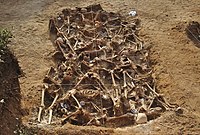
Photo from wikipedia
Recent large tsunamis in the twenty-first century have provided graphic reminders of the catastrophic impacts such natural hazards can have upon coastal communities. Death tolls in the thousands give rise… Click to show full abstract
Recent large tsunamis in the twenty-first century have provided graphic reminders of the catastrophic impacts such natural hazards can have upon coastal communities. Death tolls in the thousands give rise to the rapid adoption of coastal mass burials for the interment of the dead. While recognised as a necessary practice in the aftermath of such contemporary tragedies, the paucity of coastal mass burial sites related to earlier tsunamis reported in the archaeological record is unusual. We establish a suite of criteria for identifying the geological and archaeological evidence of inundation by past tsunamis and review case studies from two well-documented prehistoric coastal mass burial sites in the Southern Hemisphere (Solomon Islands and Vanuatu). To varying degrees, both sites possess numerous characteristics that suggest direct correlation with previously reported catastrophic palaeotsunamis. In the Northern Hemisphere, we investigate palaeotsunami inundation as an alternative hypothesis for mass burial sites in Orkney and Shetland, a relatively tectonically inactive region where such an association is unlikely to have ever been considered. The nature, chronology and location of these mass burial sites fit well with the proposed archaeological evidence for palaeotsunami inundation, and they also appear to be contemporaneous with the as-yet poorly documented Garth tsunami (~ 5500 years BP). We suggest that a potentially key diagnostic criterion for determining a palaeotsunami linkage is the use of diatom testing on skeletal remains to establish whether death was caused by drowning in saltwater, a test which has never been applied in this context.
Journal Title: Journal of Archaeological Method and Theory
Year Published: 2019
Link to full text (if available)
Share on Social Media: Sign Up to like & get
recommendations!